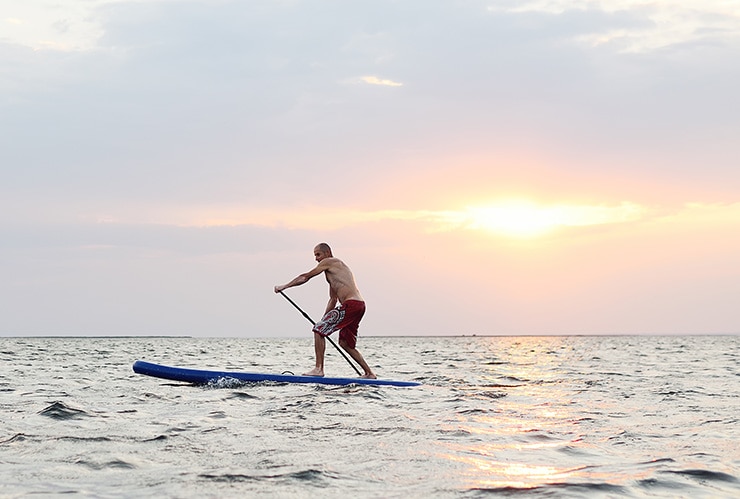Wind is a key factor when it comes to stand up paddle boarding; you always have to check the weather forecast to know what wind speed and direction you’ll be dealing with, as well as other weather issues. But even if you check the forecast – sometimes the weather will surprise you.
There’ll come a time when you will find yourself dealing with a strong wind. That can be tough, maybe even dangerous.
Learning how to paddle into the wind ensures that you’re prepared for anything. You’ll be able to control your SUP and get back to shore safely, so it’s definitely something you should learn more about, and put into practice.
Key Takeaways
- It’s important to know how to paddle into the wind for safety reasons, as strong winds can be tough to deal with, no matter how fit you are.
- Learning how to paddle board into the wind effectively can help you conserve energy and avoid getting pushed off course and potentially into dangerous or unfamiliar areas.
- By adjusting your stance and paddling with powerful, frequent strokes with your hands lower down the paddle shaft, you can reduce wind resistance and paddle into the wind more effectively.
- Paddling into the wind is something every paddler has to deal with at some point. Even if you’re an experienced paddle boarder, you should always check the weather, wear a PFD and leash, and paddle with a low center of gravity if you end up facing strong winds.
Read on for some essential tips to help you paddle effectively against the wind.
RELATED: How Much Wind Is Too Much for Paddle Boarding?
Keep a Low Center of Gravity
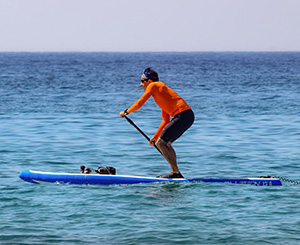
If you’re paddling upwind, your biggest problem will be wind resistance. This is because, when you’re standing, your body provides more resistance against the wind. Think of it like your body acting as a huge sail, slowing you down and making it harder for you to paddle.
When you lower your center of gravity, you reduce the resistance (as you make the ‘sail’ smaller) and your paddling efforts will be much more fruitful.
Bend your knees a little more to get lower and crouch. If the wind picks up and you start struggling, kneel down to further minimize windage. If you have a kayak seat you can also sit and paddle.
Some paddlers may find it easier to prone paddle board in very strong winds. This is where you lie on the SUP on your stomach and paddle with your arms.
In addition to reducing resistance, lowering your center of gravity also increases stability. Rough conditions can make the paddle board feel unstable and you may end up in the water.
Lower Your Hands on the Paddle Shaft
The second useful tip for paddling into the wind is adjusting your grip.
Lower your hands on the paddle. Instead of having one hand on the handle at the top, lower it so it’s on the shaft.
Having your hands low on the paddle shaft makes it easy for you to paddle while crouching. If you insist on having the upper hand on the handle, you’ll be forced to raise your hand higher during a paddle stroke. Not only is this tedious and less effective on a windy day, but it could also cause a shoulder injury if you’re not careful!
Paddle With Powerful, Frequent Strokes
A proper paddle stroke starts as far forward as you can reach and ends at your feet. This is for when you’re paddling in normal conditions. But when paddling into the wind, you need stronger and more frequent strokes to help you go faster.
Instead of ending the paddle strokes past your feet, end them at your toes or just before your toes. This way, you won’t lose momentum during recovery. Ending your strokes sooner also allows you to make more strokes per minute and you’ll go faster.
Make sure the strokes are more powerful too. You can achieve this by lowering your hands down the shaft as we’ve discussed above. It’s a technique that will make it possible for you to bury your blade deeper into the water, giving more power to your stroke.
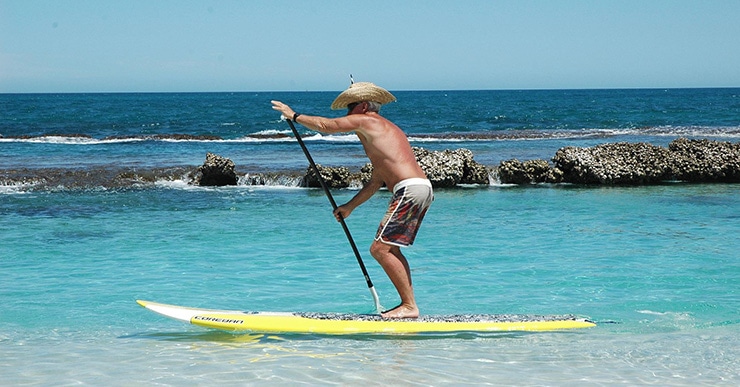
Adjust Your Stance
The shape and design of your paddle board can make things tougher when paddling into a headwind. A wider nose and one with more curvature (where the nose is raised above the water) will result in more resistance.
The wind blows in the space between the nose and the water creating more windage. If your SUP board is like this, adjust your position and move forward on the board. So instead of standing at the center carry handle, stand in front of it.
Adjusting your stance so you are putting more weight towards the front pushes the nose closer to the water, reducing the resistance.
Always Wear Your Life Vest
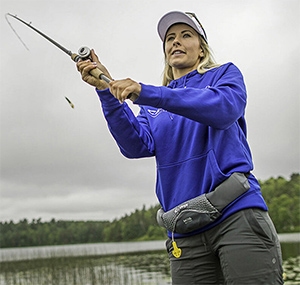
A personal flotation device is one of those things you must never go into the water without. Every paddler under 12 in the USA is required by law to have a USCG-approved life vest while paddling, but it’s advisable for everyone to wear one.
If you end up paddling in windy conditions, you may end up more tired than you normally would be (dealing with headwinds can be fatiguing), or you might be more likely to fall off your board.
In short, paddling in windy conditions could be less than ideal, so it’s important to ensure you’ve taken the right safety precautions.
After all, if something happens, a PFD in your dry bag or on the deck won’t be of much help to you. So I strongly recommend wearing your life jacket at all times while paddling–whether on a calm lake or the sea.
It’s especially more important in rough or windy conditions. If you’re dealing with a strong wind and waves you can easily fall. When that happens, you want to be able to remain afloat, even if you get hurt.
Make it a personal rule to always wear your PFD, regardless of the conditions. Most paddlers complain that they’re bulky and uncomfortable. But SUP PFDs come in different designs now and they’re much more comfortable.
Use a Paddle Board Leash
Another accessory that you must never leave the shore without is your paddle leash. Windy conditions are more turbulent and might increase your chances of going overboard, so it’s even more important to use a leash in these circumstances.
If you fall into the water, you’ll have some comfort knowing that you still have your paddle board. Without a leash, your SUP board can quickly drift away, especially with serious wind waves.
With a SUP leash, you will be attached to the board even when you fall off. You’ll have something to keep you out of the water and you can use it to get to safety.
Check the Weather Before You Paddle Board
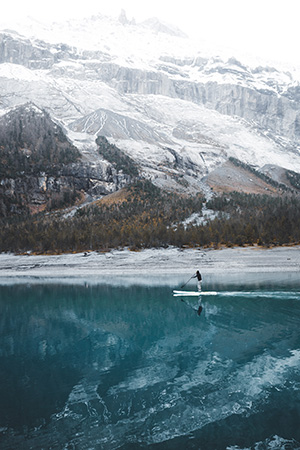
Last but not least, check the water and weather forecast before heading out on your paddle board. All good paddling trips begin with proper planning. And you can only plan well if you have an idea of what to expect.
Pay attention to factors like currents, temperature, as well as wind direction and wind speed. It would be very unfortunate having to deal with strong off-shore winds when you’re already tired, trying to make it back to shore.
Ideally, you should plan your trip such that you’re paddling in the same direction that the wind is blowing on your way back. At this point, you’ll be tired from your SUP session and the wind will be working in your favor, making your work easier.
ALSO READ: What is good weather for paddle boarding?
If this isn’t possible, find a route with obstacles like trees and cliffs to shield you from the wind.
Wrapping Up
Paddling into the wind is something that every paddle boarder eventually has to do. It’s a situation that you’ll find yourself in, sooner or later, so why not prepare for it?
The above tips have always worked for me and other paddlers. Crouch slightly to reduce your center of gravity and wind resistance. If the wind gets too strong, kneel or lie down on your belly.
Lower your grip on the SUP paddle to help you make more powerful strokes. Also, try shorter, more frequent strokes.
Don’t forget your PFD and leash. They could save you from a lot of trouble.

